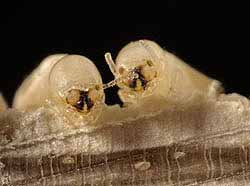Termites feed through good vibrations

Discovery that termites use vibrations to choose the wood they eat may provide opportunities to new methods of reducing infestations in homes and also may provide insights into the “cocktail party effect” of signal processing – how to ignore most noise but have some signals that trigger attention – that may prove useful in artificial intelligence.
CSIRO entomologist Theo Evans says laboratory experiments have found that termites use their ability to detect vibrations to determine which food source is most suitable. The termites can also detect how the vibrations are made. This ability could be likened to a form of sonar.
Dr Evans says different termite species are known to prefer eating particular sizes of wood; certain drywood termites prefer small blocks, presumably to avoid competition. With Professor Joseph Lai and his students from the University of New South Wales at the Australian Defence Force, Dr Evans investigated how the blind insects measured pieces of wood.
They recorded the vibrations of worker drywood termites as they fed on large and small wood blocks. Dr Evans then broadcast the recorded vibrations made by termites from the large blocks into small blocks and found that the termites switched their preference to the large blocks. Prof Lai created an artificial signal similar to that made by the termites chewing the large block, which Dr Evans broadcast into small blocks and the scientists found that the termites had no preference for either large or small blocks. Broadcasting static into small blocks did not affect termite choice, showing that the termites were not interested in random noise.
These results show two responses by the termites: one to block size and a second to signal source. The artificial signal mimicked the characteristic frequency of the wooden block, so the termites were tricked into believing that a small block with the artificial signal was the same size as a large block; thus no preference was observed. However, the signal from the termites feeding on large blocks had this characteristic frequency plus other signals indicating the presence of other termites in that “large block”, so they chose to feed on the large block without termites. Thus the termites showed that they have the “cocktail party effect”.
This social information had another important effect: limiting reproduction potential. Most termite workers are sterile; they don’t breed. However, in drywood termites, workers can become fertile and develop into breeders when they are isolated from their colony. Few workers developed into breeders in the experiments when they were broadcast the termite sourced signals, whereas many workers developed into breeders when artificial signals were broadcast, or when no signals were broadcast.
Scientists are hoping to find ways to interfere with the termites’ ability to select wood in order to reduce the economic impact of termite damage. “There is a common perception that termites are voracious and indiscriminate eaters, consuming all the wood that they find”, Dr Evans says. “But the reality is that termites are selective feeders and choose their food very carefully. The palatability of the wood species and hardness is important as are defensive chemicals made by the plant. But our work shows that this is not the only method of assessment. There are many accounts of termites not consuming a piece of palatable wood.”
Listen to termites walking and chewing pine http://www.csiro.au/audio/termite_Feb05.mp3 [mp3 file, 1 Mb, 59 sec]
Termite pictures:
http://www.scienceimage.csiro.au/index.cfm?event=site.image.detail&id=2583
http://www.scienceimage.csiro.au/index.cfm?event=site.image.detail&id=2584
Further Information:
Dr Theo Evans, CSIRO Entomology, Termite Group 02 6246 4195
Professor Joseph Lai 02 6268 8272
Media Assistance:
Julie Carter, CSIRO Entomology 02 6246 4040 or 0439 033 011
Media Contact
More Information:
http://www.csiro.auAll latest news from the category: Life Sciences and Chemistry
Articles and reports from the Life Sciences and chemistry area deal with applied and basic research into modern biology, chemistry and human medicine.
Valuable information can be found on a range of life sciences fields including bacteriology, biochemistry, bionics, bioinformatics, biophysics, biotechnology, genetics, geobotany, human biology, marine biology, microbiology, molecular biology, cellular biology, zoology, bioinorganic chemistry, microchemistry and environmental chemistry.
Newest articles

Combatting disruptive ‘noise’ in quantum communication
In a significant milestone for quantum communication technology, an experiment has demonstrated how networks can be leveraged to combat disruptive ‘noise’ in quantum communications. The international effort led by researchers…

Stretchable quantum dot display
Intrinsically stretchable quantum dot-based light-emitting diodes achieved record-breaking performance. A team of South Korean scientists led by Professor KIM Dae-Hyeong of the Center for Nanoparticle Research within the Institute for…

Internet can achieve quantum speed with light saved as sound
Researchers at the University of Copenhagen’s Niels Bohr Institute have developed a new way to create quantum memory: A small drum can store data sent with light in its sonic…





















